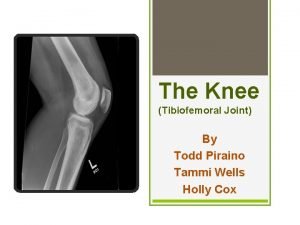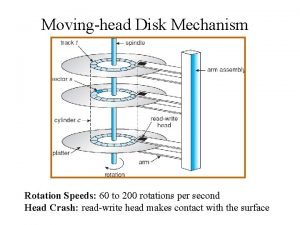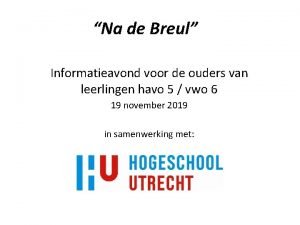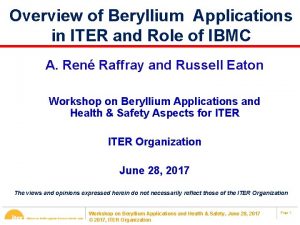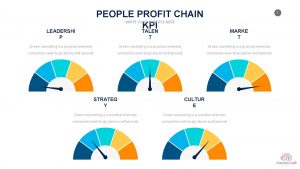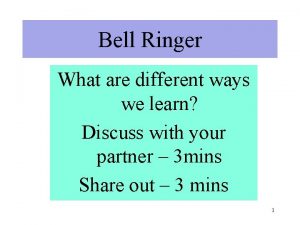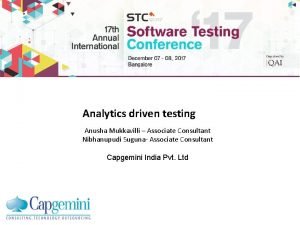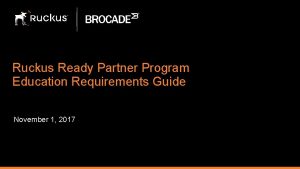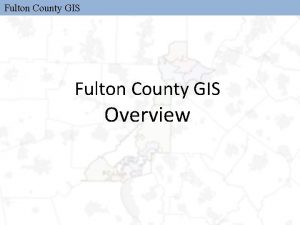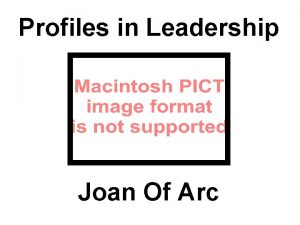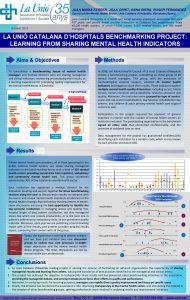Dr Joan Fulton Professor and Associate Department Head



























































- Slides: 59

Dr. Joan Fulton Professor and Associate Department Head Department of Agricultural Economics Purdue University The Economics of Entrepreneurship


Nobel Prize in Economics - 2010 �Peter Diamond, Dale Mortensen, Christopher Pissarides �For their analysis of markets with search frictions.

Nobel Prize in Economics - 2009 �Elinor Ostrom and Oliver Williamson �For “her analysis of economic governance, especially the commons. ” and “his analysis of economic governance, especially the boundaries of the firm. ”

Nobel Prize in Economics - 2008 �Paul Krugman �For his analysis of trade patterns and location of economic activity

Nobel Prize in Economics - 2007 �Leonid Hurwicz, Eric Maskin and Rober Myerson �for “having laid the foundations of mechanism design theory. ”

Nobel Prize in Economics - 2004 �Finn E. Kydland, Edward C. Prescott �“for their contributions to dynamic macroeconomics: the time consistency of economic policy and the driving forces behind business cycles. ”

Nobel Prize in Economics � 2003 Engle III and Granger – “for methods of analyzing economic time series with time-varying volatility (ARCH)” � 2002 Daniel Kahneman and Vernon Smith – “for having integrated insights from psychological research into economic science, especially concerning human judgment and decision-making under uncertainty. ” and “for having established laboratory experiments as a tool in empirical economic analysis, especially in the study of alternative market mechanisms. ”

Nobel Prize in Economics � 2002 George Akerloff, A. Michael Spence and Joseph E. Stiglitz – “for their analyses of markets with asymmetric information. ” � 2001 James Heckman and Daniel Mc. Fadden – for “development of theory and methods for analyzing selective samples” and for “development of theory and methods for analyzing discrete choice”

Joan’s Journey through The Economics of Entrepreneurship: Theory and Application

Undergraduate Studies - Excitement Accounting 101 Economics 101

Undergraduate Studies – Disillusionment – Wow

Undergraduate Studies – Practicality �The Dilemma Change Majors or Get a Degree in 4 Years �The Solution Bachelor of Commerce (business) ▪ Honors in Economics This path allowed me to complete my Bachelor’s degree in 4 years while still focusing on economics �So my career has combined business and economics from the start

Graduate Studies �University of Western Ontario London, Ontario, Canada �MA in Economics �Very Theoretical Mathematical models of economics with no application was not sufficient for me at that time �Decided that I needed to experience the business world

Corporate Experience �Spent 2 years as Strategic Analyst in Corporate Planning Department of the Potash Corporation of Saskatchewan

Back to Economics �Pulling It All Together with Economics � 5 years teaching intro and intermediate economics at University of Saskatchewan �“You really learn something when you have to teach it. ”

Ph. D. Studies �Taking Economics to the Next Level After 2 years working in a corporate environment and 5 years teaching introductory and intermediate economics I was prepared to see the value of theoretical modeling of economic concepts using high level mathematics Applications of economics to business environment (farm business management, cooperative management, logistical examples) were an integral part of the program

Ph. D. –Dissertation Research �Centralized versus Decentralized Decision Making in Grain Marketing Cooperatives Professors Prescott and Hurwicz were both on my Ph. D. committee Initial theory suggested we should see more decision making activity at centralized level – but my empirical results found bulk of activity at decentralized level ▪ Revisiting the model to consider the extent of the uncertainty

Research on Cooperatives �Following Ph. D. my research examined Member Commitment to their Cooperatives Situations where cooperative structures CAN and DO work ▪ Where joint ownership and joint responsibility are recognized by all of the decision makers so people do not “free ride” Factors affecting success with Joint Venture and Strategic Alliance agreements Effectiveness of New Generation Cooperatives

Research on Cooperatives/Agribusiness �Customer Satisfaction with their Cooperatives �Managing multi location facilities for grain marketing cooperatives �Consolidation of agricultural cooperatives over time �Effectiveness of Word of Mouth Marketing

Small Business Development �Value Added Businesses can be important – especially in agriculture �Challenge for small business owners can be the lack of business skills (marketing, finance, planning) Often they have the skills for the technical production aspect of the business �Large percentage of small businesses fail Business planning significantly increases chance of success

Importance of Business Planning �Although building a plan does not guarantee success, it does increase your chances of succeeding in business. �Research has shown that attempting to write a business plan increases your chances of starting a business by 24%. �A plan is like a road map.

Women Entrepreneurs Fighting Poverty 23

Factors Affecting the Success of Women Street Food Vendors in Niger Miriam Otoo Graduate Student, Dept. of Ag. Econ, Purdue University Germaine Ibro Economist, Institut de Recherche Agronomique du Niger Joan Fulton Professor, Dept. of Ag. Econ, Purdue University James Lowenberg-De. Boer Assoc. Dean Int. Programs in Ag. , Purdue University 24

Informal Sector and Street Foods � Women hold a central role in this sector, � They use traditional skills and little capital to prepare food from scratch using local cereals and grains. � Provide important nutrition for all consumers and especially the urban poor � Important product from cowpeas: Kosaï 25

Kosaï � Essential source of inexpensive ready-toeat food for workers of every class and occupation. � Kosaï: consumed at anytime of day: for breakfast and as a snack between lunch and dinner. 26


Objective � The objective of this work is to identify the factors that affect the success or women entrepreneurs involved in kosaï production and sales in the three largest cities of Niger (Niamey, Maradi and Zinder) 28

Data �Census of Kosai Vendors Niamey Maradi Zinder �One-on-one Interviews with Random Sample of Vendors 29

Educational Level of Vendors Between 50% and 60% of vendors have no formal education Primary education: 25% in Niamey, 8% in Zinder and 4% in Maradi 30

Expenditure Outlets for Income from Kosaï - Savings: 80%, 77% and 67% of vendors in Niamey, Zinder and Maradi respectively; Maradi and Zinder vendors used earnings for immediate expenditures 31

Regression Analysis �Two Measures of Success Considered �Size Quantity of cowpea used per day is proxy for size of business operation OLS regression analysis with size as dependent variable �Growth Self reported perception of the women. Variable equal to 1 if she was experiencing growth, 0 otherwise Binary Logit analysis 32

�Success = f(education, experience, business constraints)

OLS Analysis with Size as Measure of Success � R 2 values are low � Experience (years in business) - positive and statistically significant for all models - indicates that vendors with more experience are more successful; � Capital Constraint variable: - negative and statistically significant for two of the models - vendors identifying capital equipment as an important constraint are less likely to be successful; � Cowpea Constraint variable: - negative and statistically significant for all models - vendors who find purchasing cowpea as an important constraint are less likely to be successful. 34

OLS Analysis with Size as Measure of Success • Dummy variables for education: • not statistically significant • Indicates that level of education does not affect the level of success for the Kosaï vendors. • Dummy variables for city: • statistically significant – but suggest that may be picking up some other factors 35

Binary Logit Analysis with Growth as Measure of Success � Likelihood ratio tests show that all models are statistically significant. � Experience (years in business) - positive and statistically significant for all models. - corroborates the results of the OLS model. � Capital Constraint - Negative and statistically significant Ø Cowpea Constraint Ø Negative and statistically significant - This supports Esim’s (2001) findings, who cites nonavailability of raw materials as a major constraint faced by women micro-entrepreneurs in developing countries 36

Binary Logit Analysis with Growth as Measure of Success � Dummy Variable for Education - Coefficients are negative and significant , not expected; - Vendors with more education have other employment opportunities; - Vendors with secondary education usually younger and single and enter into Kosaï production just to save enough money for continuing their education or for their trousseau; � Family Size - variable is positive and statistically significant, implying Kosaï vendors with larger family size were more likely to experience growth; - family members provide free or inexpensive labor. � Dummy variables for city: - Similar to OLS results, these variables are statistically significant but are most likely picking up other effects 37

Conclusions � The production and selling of Kosaï by women street vendors in West Africa is an important economic activity Uses a significant amount of cowpea Provides nutritious food for general population Provides important income for the women who spend the money on their families � Experience is an important factor contributing to success � Production constraints are also important Capital Purchasing the cowpea every day Preparing the batter 38

Next Steps �Explore other measures of success �Explore the production constraint of “Preparing the Batter” Joint work with Food Scientists Have identified a potential new line of business ▪ Making a dry cowpea product for quick mix of kosaï 39

Women Entrepreneurs Fighting Poverty 40

What do Kids Need to Know

What are the Basic Business Skills Needed? �Profit = Revenue – Costs �Revenue equals Selling Price times Number of Units Sold �Costs Fixed Costs ▪ Those costs that you incur even if you produce/sell nothing Variable Costs

Revenue and Costs Projections THE BUDGETING PROCESS

Revenue Projections �Marketing Plan Consider each Market Segment ▪ Number of customers who are potential – and who will BUY ▪ Number of units each customer will buy ▪ Price customer will pay ▪ Price times Quantity = REVENUE from that segment Add up Revenue Across all Segments

Cost Projections �Go through all aspects of the operation and identify the costs �Fixed Costs – you will get a total �Variable Costs – most of these will be on a per unit of product produced basis �Add up all costs for the amount you project to product to get Total Costs

Remember �Profits = Revenue - Costs

Competitive Analysis �Careful evaluation of ALL of your competitors � 5 Forces Publication is excellent resource here �There is ALWAYS Competition Sometimes it is “do nothing” �Your entry into the market may cause an unexpected reaction by a competitor – plan for this as much as possible

Marketing Plan �What is the Core Benefit your product/service provides? �What are the needs that your primary customers have? �How does the Core Benefit of your product fit with the needs of your customers? What are the implications for marketing?

Planning �Planning is extremely important because It provides a ROAD MAP Following the plan is the best way for all people involved in the business to be “on the same page” If things don’t go as expected you can look to the map to see what the appropriate “detour” will be �Research has shown the value of planning - attempting to write a business plan increases your chances of starting a business by 24%.

Available Tools

Purdue’s On-Line Business Planning Tool: In. Venture For more information see the lecture from the first evening https: //www. agecon. purdue. edu/planner/

Purdue’s AICC/New Ventures Publications We have a set of over 20 publications targeted for small business management. Check out these! They are all free of charge! https: //www. agecon. purdue. edu/planner/res ources/

Marketing's Four P's: First Steps for New Entrepreneurs, EC-730 The publication on the 4 Ps of Marketing is closely related to the material covered in the 2 nd session. Note that the publication is all about Marketing material but is presented a bit differently than the material in the 2 nd session in other words don’t expect it to be just the same. http: //www. ces. purdue. edu/extmedia/EC/EC 730. pdf

Industry Analysis: the Five Forces, EC-722 The publication that helps entrepreneurs think about the competitive environment they are operating in may be helpful for many people http: //www. ces. purdue. edu/extmedia/EC/EC 722. pdf

General Licensing, Regulatory and Tax Requirements for Indiana Businesses, EC-733 For people who are just starting to think about the new business the following publication can help entrepreneurs sort through the process of taking care of all licenses. https: //www. agecon. purdue. edu/newventures/var/EC 733. pdf

Check out this page with all of the list of publications – we just had a sampling this evening! https: //www. agecon. purdue. edu/planner/resour ces/

On-Line Materials on Grant Writing https: //www. agecon. purdue. edu/newventures/Gran t_Writing/index. html Here you will find a set of resources that will be useful when you are preparing to develop and submit a grant proposal. The resources include: a Quick time video with background, A Quick Time video with a specific example, A publication(with important worksheets) on Grant Writing.

�http: //in. marketmaker. uiuc. edu/

Thank you and I look forward to your questions.
 Promotion from assistant to associate professor
Promotion from assistant to associate professor Joan fulton
Joan fulton Name the picture
Name the picture Immunofluorescence
Immunofluorescence Cara fulton
Cara fulton Intuitive designs fallout 4
Intuitive designs fallout 4 Pearl fulton bliss
Pearl fulton bliss Fulton montessori
Fulton montessori Fulton breen
Fulton breen Fulton sheen
Fulton sheen Tarping fulton county
Tarping fulton county Mcb 101
Mcb 101 Fulton county ess
Fulton county ess Derrick fulton
Derrick fulton Característica del microscopio
Característica del microscopio Georgia dfcs investigation protocol
Georgia dfcs investigation protocol Dividing head calculations chart
Dividing head calculations chart Flood suction pump
Flood suction pump Hod head of department
Hod head of department The attacking firm goes head-to-head with its competitor.
The attacking firm goes head-to-head with its competitor. Html tagi
Html tagi Operation of moving head disk storage
Operation of moving head disk storage Head body parts
Head body parts What is the tonic syllable
What is the tonic syllable Biceps femoris innervation
Biceps femoris innervation Pre-head head tonic syllable tail
Pre-head head tonic syllable tail The head of moving head disk with 100 tracks
The head of moving head disk with 100 tracks Mbcs membership
Mbcs membership Tecniche associate al pensiero computazionale:
Tecniche associate al pensiero computazionale: What does this drawing indicate about the inca civilization
What does this drawing indicate about the inca civilization Lonestar nursing application
Lonestar nursing application Certified system engineering professional
Certified system engineering professional Direct mapping cache
Direct mapping cache Cern hr
Cern hr Associate degree in the netherlands
Associate degree in the netherlands Laser alignment
Laser alignment Physician associate lecturer
Physician associate lecturer Stratog online lectures
Stratog online lectures Tio collegegeld
Tio collegegeld What is an associate director
What is an associate director Harper college associate degrees
Harper college associate degrees Iter project associate
Iter project associate Aad program
Aad program Los angeles harbor college nursing
Los angeles harbor college nursing Reading is an active process
Reading is an active process Delta chi flag
Delta chi flag Associate degree rmit
Associate degree rmit Adobe spark certification
Adobe spark certification Cincinnati state associate degrees
Cincinnati state associate degrees Safety associate
Safety associate Associate warden
Associate warden Customer kpi
Customer kpi Imeche associate membership
Imeche associate membership To associate
To associate Hea associate fellowship
Hea associate fellowship Associate consultant in capgemini
Associate consultant in capgemini Associate program
Associate program Associate consultant in capgemini
Associate consultant in capgemini Mhp associate partner gehalt
Mhp associate partner gehalt Ruckus certified partner
Ruckus certified partner
























